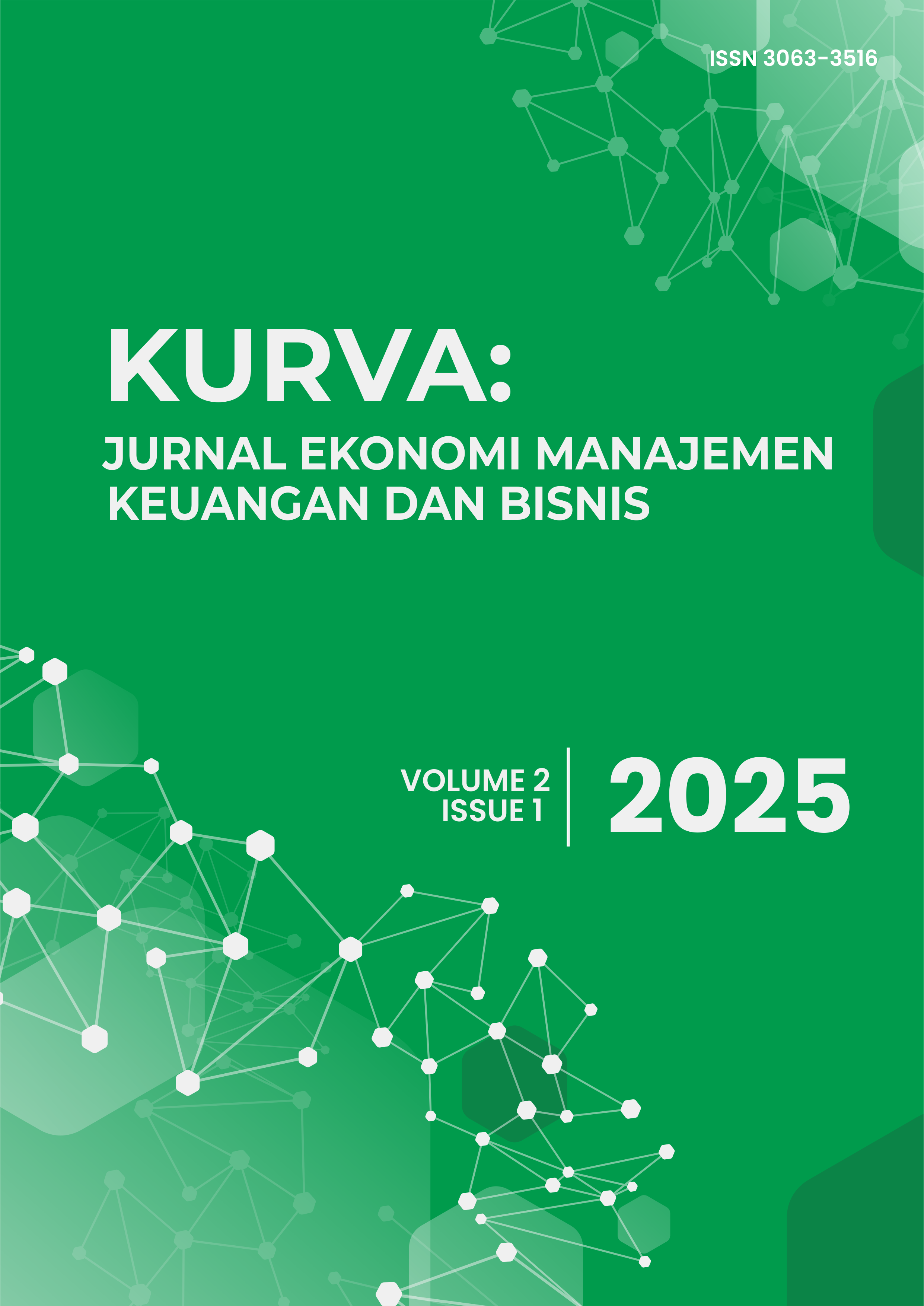Analisis strategi penyelesaian kredit bermasalah di KC PD BPR Artha Galunggung Cabang Manonjaya
DOI:
https://doi.org/10.53088/kurva.v2i1.2270Keywords:
Credit Distribution Quality, Problem Loan Handling Strategies, Non-Performing Loans ObstaclesAbstract
This study aims to analyze the quality of credit distribution, strategies for resolving non-performing loans (NPLs), and identify the obstacles and factors that contribute to loan defaults at KC. PD. BPR Artha Galunggung, Manonjaya Branch. A mixed-methods approach was employed, combining quantitative analysis of credit collectibility data with qualitative insights from interviews and observations. The findings reveal that although credit distribution has increased, its quality remains relatively unhealthy, as indicated by a rising NPL ratio over the past three years, particularly in 2023. The bank has implemented several handling strategies, including direct visits to borrowers, business condition analyses, credit restructuring, and rescheduling of repayments. However, these measures have not been fully effective in reducing the level of non-performing loans. The root causes of problem loans stem from both internal factors, such as weak creditworthiness analysis, and external factors, including declining business performance and borrowers’ financial incapacity. Additional challenges include difficulties in communication with debtors and the limited effectiveness of the approaches taken. Therefore, strengthening credit analysis systems and adopting more human-centered and adaptive resolution strategies tailored to borrowers’ economic conditions are essential to lowering NPLs and maintaining banking health.
References
Alminanda, P., & Marfuah, M. (2018). Peran komitmen organisasi dalam memoderasi pengaruh kompetensi sumber daya manusia, sistem pengendalian intern dan pemanfaatan teknologi informasi terhadap kualitas laporan keuangan pemerintah daerah. Jurnal Analisis Bisnis Ekonomi, 16(2), 117-132. https://doi.org/10.31603/bisnisekonomi.v16i2.2620
Astuty, H. S. (2015). Prinsip 6C (character, capacity, capital, condition of economy, collateral dan constraint) dalam wirausaha mahasiswa. Jurnal Economia, 11(1), 19752.
Brusca-Alijarde, I., Labrador-Barrafón, M., Blasco-Burriel, M. P., y Esteban-Salvador, L. (2017). Impacto del género y la responsabilidad social en la rentabilidad empresarial cuando se controlan los recursos estructurales e intangibles. Revista Perspectiva Empresarial, 4(2), 59–72. https://doi.org/10.16967/rpe.v4n2a7
Cahyaningtyas, R. A., & Darmawan, A. (2020). Pengaruh 5C (Character, Capacity, Capital, Collateral, dan Condition of Economy) Terhadap Pemberian Kredit Studi Kasus Koperasi Pegawai Telkom Purwokerto. Kompartemen: Jurnal Ilmiah Akuntansi, 17(1). https://doi.org/10.30595/kompartemen.v17i1.2792
Dewi, N. M. I. P., & Sedana, I. B. P. (2017). Efektivitas Manajemen Risiko Dalam Mengendalikan Risiko Kredit Di PT Bank Rakyat Indonesia. E-Jurnal Manajemen Unud, 6(8), 4298-4331.
Fatika, N. A. F. N. A., & Andayani, A. (2024). Pengaruh Kualitas Aset, Tingkat Efisiensi, Likuiditas Terhadap Rasio Kecukupan Modal Pada Bank Perkreditan Rakyat. Jurnal Ilmu dan Riset Akuntansi (JIRA), 13(7), 240-255.
Firdaus, I., & Kasmir, A. N. (2021). Pengaruh price earning (PER), earning per share (EPS), debt to equity ratio (DER) terhadap harga saham. Jurnal Manajemen Dan Bisnis, 1(1), 40-57. https://doi.org/10.32509/jmb.v1i1.1338
Hidayat, A., Lesmana, S., & Latifah, Z. (2022). Peran Umkm (Usaha, Mikro, Kecil, Menengah) Dalam Pembangunan Ekonomi Nasional. Jurnal Inovasi Penelitian, 3(6), 6707-6714. https://doi.org/10.47492/jip.v3i6.2133
Manoppo, R. M. (2013). Analisis sistem pengendalian intern penerimaan dan pengeluaran kas pada PT. Sinar Galesong Prima Cabang Manado. Jurnal EMBA: Jurnal Riset Ekonomi, Manajemen, Bisnis dan Akuntansi, 1(4), 1007-1015. https://doi.org/10.35794/emba.1.4.2013.2837
Nursyahriana, A., Hadjat, M., & Tricahyadinata, I. (2017). Analisis Faktor Penyebab Terjadinya Kredit Macet. In FORUM EKONOMI: Jurnal Ekonomi, Manajemen dan Akuntansi, 19(1), 1-14. https://doi.org/10.30872/jfor.v19i1.2109
Onoda, A. (2024). Pengaruh Non-Performing Loan (NPL), Operational Cost and Operasional Revenue (BOPO), Dan Capital Adequacy Ratio (CAR) Terhadap Return of Assets (ROA) pada Perusahaan Perbankan yang Telah Terdaftar di BEI pada Periode 2019–2023. eCo-Sync: Economy Synchronization, 1(4), 1-16.
Perbarindo, (2023) Perhimpunan Bank Perkreditan Rakyat Indonesia. https://perbarindo.org/profile/bpr/877
Saputra, E., Resmi, S., Nurweni, H., & Prasetyo, T. U. (2020). Do Character, Capacity, Capital, Collateral, and Conditions as Affect on Bad Loans. Journal Of Accounting And Finance Management, 1(3), 93-100. https://doi.org/10.38035/jafm.v1i3.17
Setiawan, A., & Luthfiyani, U. K. (2023). Penggunaan ChatGPT untuk pendidikan di era Education 4.0: Usulan inovasi meningkatkan keterampilan menulis. JURNAL PETISI (Pendidikan Teknologi Informasi), 4(1), 49-58.
Tintami, L., Pradhanawati, A., & Nugraha, H. S. (2013). Pengaruh budaya organisasi dan gaya kepemimpinan transformasional terhadap kinerja karyawan melalui disiplin kerja pada karyawan harian SKT Megawon II PT. Djarum Kudus. Jurnal Ilmu Administrasi Bisnis, 1(1), 189-196. https://doi.org/10.14710/jiab.2013.1634
Downloads
Published
How to Cite
Issue
Section
License
Copyright (c) 2025 Dwiyan Al Rasyid

This work is licensed under a Creative Commons Attribution-ShareAlike 4.0 International License.
Authors who publish with this journal agree to the following terms:
The author(s) retain copyright and grant the journal the right of first publication with the work simultaneously licensed under a CC BY-SA 4.0 license that allows others to remix, adapt, and build upon the work even for commercial purposes, as long as they credit the author(s) and license their new creations under the identical terms.
License details: https://creativecommons.org/licenses/by-sa/4.0/


